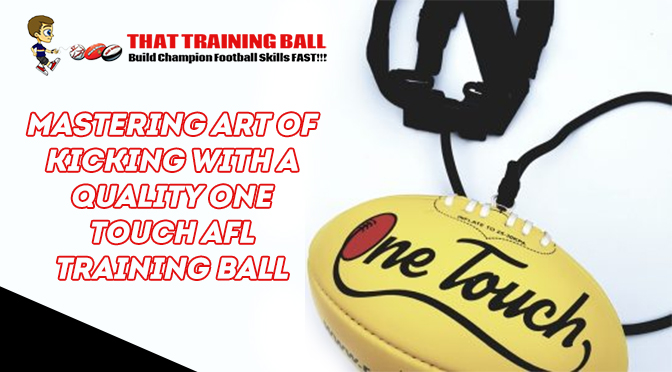There are 5 methods to score in rugby. Of them, 3 are achieved by kicking the ball. Thus, a good kicker is an asset of a rugby team. Therefore, if you want to be an indispensable part of any professional rugby team, you need to master the art of kicking and this is where the role of a quality training ball comes in the forefront.
You need to master the art of various types of kicks, from those on-ground grubber kicks to the punts, from the torpedo kicks to the high flying ups-&-unders! And of course, you cannot forget the good old penalty kicks that bring you points! All these are going to give a player that extra edge that will make him or her an integral part of a team. It will make all the difference in a closely contested match. This tells how important is mastering the art of kicking and how important training with a quality ball is. This is where the One Touch AFL Training ball that we offer at That Training Ball makes such a huge difference. The high-quality material it is made up of, the best bladder, the scientifically developed aerodynamic streamline shape, and its uniform behaviour in every weather or ground condition make it the perfect ball for mastering the art of different types of kicks in Rugby.
Now the question is, how to master the basics and what role does a good training ball play.
Tip#1: Mastering the Basics
You need to start with a set of cones arranged in rows. They will act as your targets. This comes in handy when you learn the art of taking a standing grubber kick. Here, you need to put the focus on the technique and you need to be consistent. Ideally, the ball should drop at about the height of your knee or a bit lower than that, just before your foot comes in contact with the ball. Either the top of your foot or the instep will come in to play in this type of kick. As you take the kick, the ball should drive straight into the ground and then roll end over end, with a considerable amount of stop spin, giving the ball an unpredictable bounce. Thus you see, how much the material, the weight, and the shape of the ball come in handy in a grubber kick. But for a quality ball like that of the Ross Faulkner Ball, you will not get that bounce and spin, which are the prerequisite of a good grubber kick.
Tip#2: Increasing the Challenge
As you are satisfied with your prowess in taking the grubber kick, you need to add a little bit of challenge to add some extra expertise to your arsenal. Again, a good One Touch training football will come in handy in this case. You need to incorporate some movement into the training with some basic change and recovery drills. Just set a pair of cones 10 meters apart from each other. Now make a run towards the first cone, and then drop the ball on your foot, for taking the kick as you get past the cone. The kick needs to be just what you have practiced standing in a place, driving straight forward. But then, you need to recover the ball before you reach the second cone that is 10 meters away. Now, a quality training ball, which comes with a bungee cord, comes in handy in this type of drill.
Tip#3: Making it as close to real as it can be
The best way of mastering the art of kicking is practicing with a team. Surely, when you practice with a team, you can opt for a more advanced avatar of these drills, with a team of 4 to 5 practicing the kicks by simulating match situations, helping you to get the live match feeling. This further helps you to master the art. And then, use that knowledge to further perfect the art during your personal training sessions and in your backyard, with the One Touch Rugby training ball at your disposal.
Thus you see, how handy these high-quality rugby training balls can be when it comes to mastering the art of kicking and perfecting the skills. Thus, nothing can be a better option than the One Touch Rugby training balls that we offer at That Training Ball.
Get in touch with us at 02 93993575 (Telephone) or 0490 388 954 (Mobile) to buy Ross Faulkner AFL Ball online. If you are calling from abroad, call 0061 490388954 (Mobile) or 0061 293993575 (Telephone).








